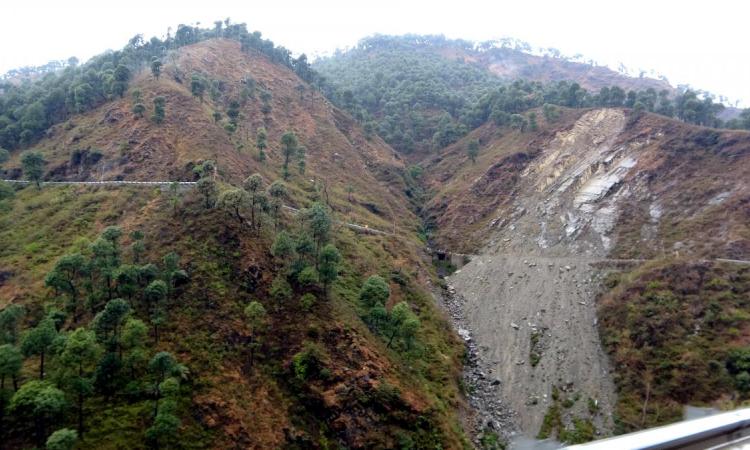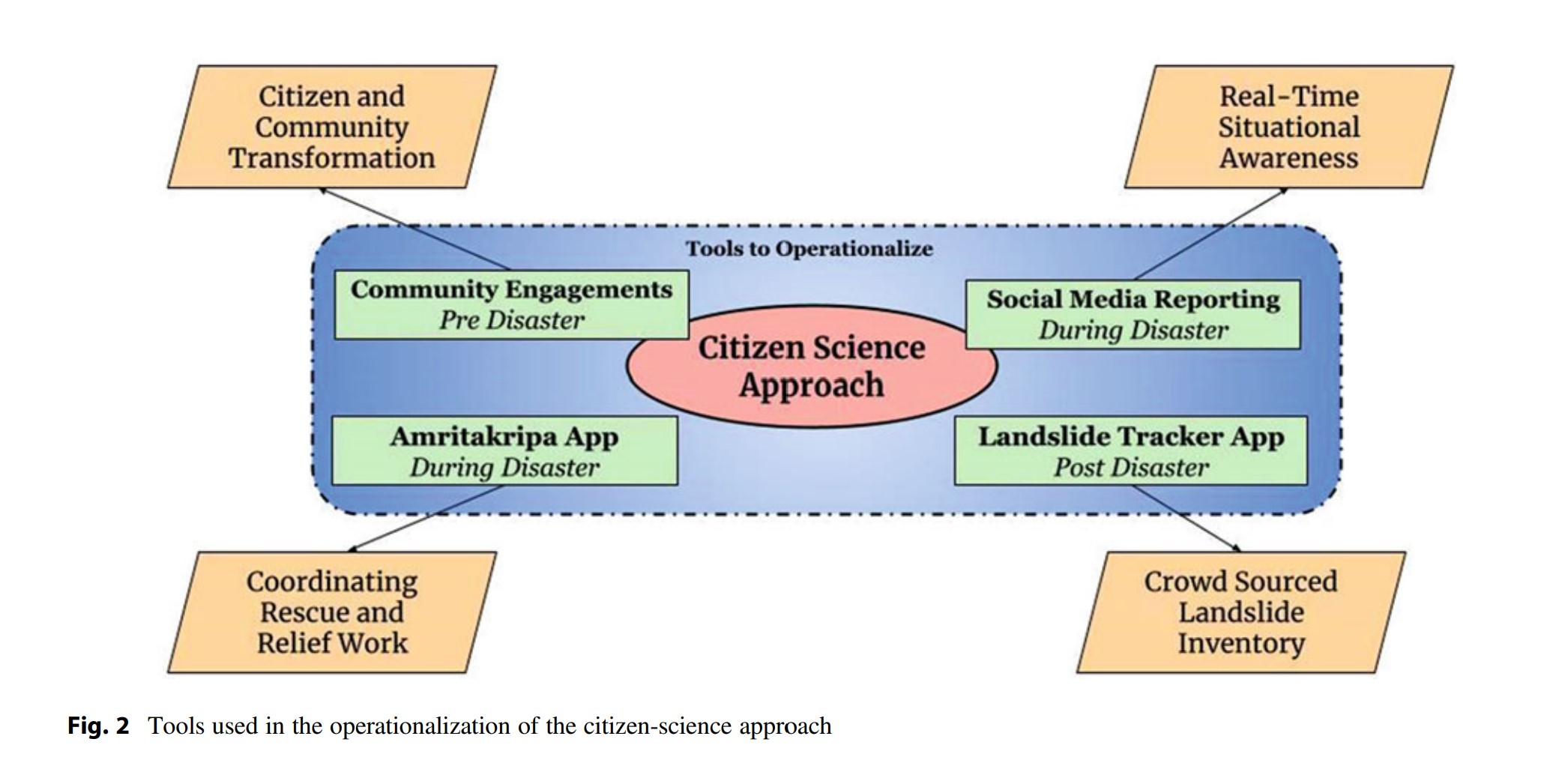
Landslides involve a massive movement of a mass of rock, debris, or earth down a slope triggered by rain, earthquakes, volcanoes, or other events that make the slope unstable. Geologists, scientists often describe landslides as a type of mass wasting, which is any downward movement in which the Earth's surface is worn away.
Landslides may include rockfalls, deep-seated slope failures, mudflows and debris flows. They can occur in places with steep or gentle slopes - from mountain ranges to coastal cliffs or even underwater. Gravity is the primary driving force for a landslide to occur, but there are many driving factors that can affect stability and weaken slopes such as a heavy rainfall, snowmelt, changes in water levels, erosion due to streams, changes in groundwater levels, earthquakes, volcanic activity, disturbances due to human activities, a slope cut to build a road, and/or a combination of these factors.
Read these Frequently Asked Questions to know more about landslides
Consequences of landslides can be serious and lead to a major loss and threat to lives due to deaths and injuries from rapidly flowing water and debris, and due to trauma or suffocation by entrapment, damage to property and infrastructure, economic losses and damage to ecosystems as being witnessed in the Wayanad tragedy last week.
Protecting communities against landslides
Mitigation measures and early warning systems can be extremely effective to protect communities against landslides. However, a gap between available scientific knowledge and the adoption of technological interventions at the community level in India due to inadequate knowledge and expertise, poor financial and governance support, lack of effective policies and pathways to access these interventions hinder progress informs this paper titled Community scale landslide resilience: A citizen-science approach published in the open access book Progress in Landslide Research and Technology, Volume 2 Issue 2, 2023. Thus, new approaches driven by the citizen centric approach that involve close multi-stakeholder partnership between civil protection officials, academicians, and community members is needed.

What are the requirements for building landslide resilient communities?
- An understanding of landslide risks is needed for identifying areas susceptible to landslides and implementing policies to restrict further development in these fragile locations.
- Landslide risk assessment and proper land-use planning and zoning can help to prevent development in areas that are susceptible to landslides and protect communities from the impacts of landslides.
- Developing building codes and standards that consider landslide risk can help ensure that buildings are constructed to withstand potential landslide hazards such as sinking or creep movements.
- Early warning systems (EWS) can help to alert residents to the potential for landslides and give them enough time to evacuate or take other protective/preventive measures.
- Educating the community about the risks associated with landslides and providing them with information on how to prepare for and respond to landslides as a community is very important for building the community’s social resilience.
- Effective coordination and collaboration between government agencies, community organisations, and community members, are essential for implementing landslide risk reduction measures and building resilient communities.
How can citizens be involved?
Pre-Disaster Measures
Identifying vulnerabilities and preparing beforehand
Building awareness among communities about their physical, economic, or social vulnerabilities and mapping these vulnerabilities can help communities stay alert, be ready in case of worst case scenarios and undertake mitigation measures to avoid losses.
Measures such as planting vegetation, blanketing the slope surface for soil erosion control, directing surface runoffs, using flexible pipes to avoid breaking up utility lines, repairing buildings, and avoiding water leakages can be very helpful in reducing the chances of a landslides. Besides, taking turns during heavy rainfall events, staying awake during the night and being prepared for worst case scenarios, identifying danger signals and alerting others to evacuate their houses can be greatly useful to prevent loss of lives and injuries. Taking special care of the vulnerable like elderly, pregnant women, and children, stocking essential supplies when shops close or roads get blocked in remote areas can help communities become well prepared to cope with emergencies.
Training for survival
Preparing survival kits (also known as an emergency/disaster kit) that includes important documents, medicines, clothes, travel kits, sanitary items, non-perishable food items in case they have to leave the place immediately can greatly help communities cope in cases of emergency situations.
Community engagement and empowering communities to use tools
Besides organising community engagement programs by engaging disaster management experts, helping the community to get acquainted with tools and technologies such as crowd-sourced apps (Ex: Landslide Tracker App, AmritaKripa App), and others can greatly help the community at various stages of the disaster. Identifying community leaders to transfer knowledge related to evacuation routes, safe grounds, and nearest relief camp locations helps increase social resilience in the community.
Gathering real time information
Watching for rainfall, river water levels, and groundwater levels through wells by gathering regular real time information on the hydrological triggers of landslides and identifying triggers such as tilting of trees which can be indicative of creep movements, surface slips indicating subsidence, fault activation, and induced seismicity.
During-Disaster Measures
On getting warnings, quickly moving communities to relief camps is most crucial and ensuring higher priority to vulnerable community members such as old aged, specially abled, pregnant women, and children becomes crucial while carrying survival kits prepared during the pre-disaster period. Once the community is established temporarily in the relief camp, the next step is to ensure that all the community members are evacuated and that no one is left behind.
Community leaders can help support further search and rescue operations by coordinating with regional government agencies in charge of disaster management, such as the Disaster Relief Force (DRF) and the Disaster Management Agency (DMA) by using crowd-sourced tools, such as Amritakripa, social media platforms, etc. The community also needs to ensure human rights protection during the disaster.
Post-Disaster Measures
Damage assessment and rehabilitation
Post-disaster management activities must be started by conducting a damage assessment that can be used to plan the further rehabilitation process and appeals to central govt agencies for financial aid. The community can also set up self-help groups (SHGs) that can engage vulnerable, poor communities and generate income for them. These activities will help in the economic and social resilience of the community. Long-term activities during the post-disaster period will help ensure the community can build back better and make itself more resilient against future disasters.

Tools for Operationalisation
Community Engagement in the design and development process
Helps build awareness and a sense of ownership, leading to resilience building. The first step towards resilience is to increase the local community’s awareness level of the potential hazards. Engaging the local community in pre-disaster drills will help people understand evacuation routes and procedures, select community leaders who can lead during such events and identify vulnerable people in their community,
Analysing information from social media
Social media has been used in disaster preparedness and management to strengthen situational awareness and improve emergency response. The common public can be informed of authoritative situational notifications by following official natural disaster management organizations on social media. This work helps the government authorities in decisionmaking and will provide situational awareness for the public
Use of technology
AmritaKripa is a disaster relief platform developed in India where users can request help regarding evacuation, medicines, and supplies, and other groups of people can provide the supplies. It has been used extensively during the 2018 and 2019 Kerala floods where helped it to organically evolve and upgrade to make it more user-friendly, flexible, and effective for managing rescue and relief efforts during single or multi-hazard situations.
Landslide Tracker Mobile App: Data collection on vital variables is necessary to enhance disaster management due to the ever-increasing landslide incidences. Amrita has created a crowdsourcing-based application to facilitate real time data collection, validation, summary, and distribution processes. This software was created and developed by Amrita Vishwa Vidyapeetham as part of the LANDSLIP research project (http://www.landslip.org/). It is also freely accessible on Google Play Store.
Practical challenges encountered in implementation
The application of the framework in real life situations in Munnar in the western Ghats and Sikkim in Himalayas reveals some practical challenges and gaps that need to be dealt with such as:
Unwillingness to relocate
Some community members show a lack of willingness to relocate to safer locations despite being told by the officials probably due to emotional attachment to their homes and communities, concerns about losing their livelihoods and about access to services and amenities in the relocated place, lack of sufficient incentives from the govt such as financial compensations to set-up new infrastructure such as building house, fencing wall, trust deficits between the community members and the stakeholders, and general social anxiety. Involving community members in the decision-making process, providing adequate support and incentives, and working closely with relevant government agencies, NGOs, and other stakeholders is important in these circumstances.
Non-transfer of indigenous knowledge
Communities have survived in a landslide-prone areas for long and they have an intricate knowledge of the area and have traditionally planned their settlements, architecture, agricultural practices, water management practices, rainwater harvesting needs etc by taking into consideration the vulnerabilities of the area.
Lack of recognition of indigenous knowledge systems, dismissal of this knowledge as non scientific by modern engineering approaches, poor documentation of traditional knowledge and practices and lack of effective collaboration and communication between indigenous communities and modern scientific communities has led to lack of empowerment among communities to cope with disasters and aid in resilience building.
Poor risk perception
Experience shows that individuals and communities often underestimate the potential risk of landslides in their area due to lack of knowledge or awareness about the local geology and topography. Disaster education, awareness programmes, engagement in citizen-stakeholder dialogues, etc., can help raise the community’s understanding of risks.
Security issues in relief camps
This is one of the major hindrances to the people’s willingness to evacuate to relief camps and temporary shelters.
Limited resources
Resilience building requires a large amount of financial, technical, and human resources. Getting approval and funding to conduct such engagement programs is a challenge. Many communities lack the necessary resources to implement and sustain resilience measures, hindering their efforts.
Poor community participation and ownership
Community participation and ownership are critical for effective landslide community resilience. However, lack of participation from the most at risk communities due to lack of time, income generation obligations, lack awareness or understanding of landslide risks often hinder mitigation efforts. Efforts at awareness generation and making communities understand the risk and the importance of their involvement in mitigation is crucial to prevent loss to lives and injuries among people.
Limited technical expertise
Landslide resilience measures need a multidisciplinary approach that involves people from different disciplines such as engineering, geology, hydrology, social sciences, health who need to work together cohesively, which needs integration several domains of knowledge, which can be very challenging.
Poor availability of good quality data
Availability of reliable data on landslide risks, vulnerabilities, and impacts is critical for effective resilience planning and implementation, but is a challenge in many landslide-prone areas, particularly in low-income countries.
Poor institutional capacity
Effective landslide community resilience requires strong local, regional, and national institutional capacity. However, many institutions lack the resources, capacity, and political will to effectively address landslide risks.
Hurdles in outreach programs
Smart moderation of the programs, effective communication skills, and support of local leadership is important to improve outreach and spread information and awareness on landslides.
The framework and the case study can provide a guideline to policymakers, community leaders, change makers, administrative officials, and researchers in disaster management in the future.
/articles/building-community-resilience-deal-landslides